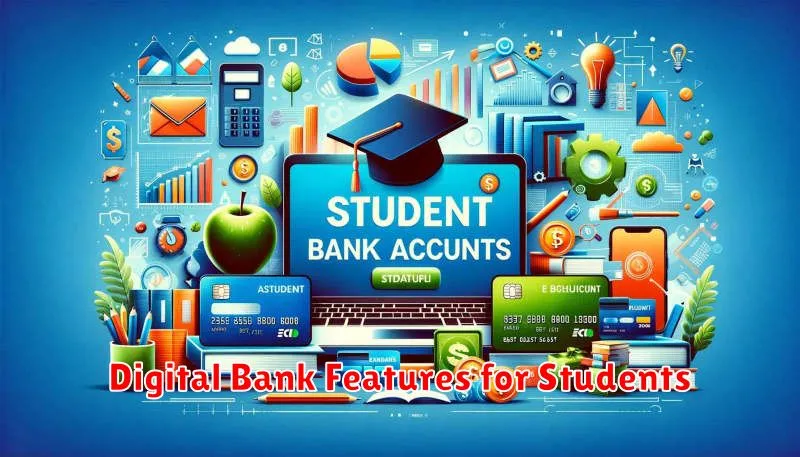Are you a student looking for a banking experience tailored to your needs? Digital banking offers a wealth of features for students, providing convenient and accessible financial management tools. From tracking expenses to building credit, digital banks empower students to take control of their finances and navigate the unique challenges of student life. Explore the advantages of digital bank features for students and discover how they can simplify your banking experience.
This article will delve into the key digital bank features for students, highlighting their benefits and explaining how they can help you manage your finances effectively. We’ll explore the advantages of mobile banking, budgeting tools, and savings options specifically designed for students. Discover how digital banking can help you stay on top of your finances, avoid unnecessary fees, and build a strong financial foundation for the future. Whether you’re a freshman just starting out or a graduate student managing complex finances, understanding the power of digital bank features is essential for your financial success.
Student-Focused Account Types
Digital banks often offer specialized account types tailored to the needs of students. These accounts typically come with perks and features designed to help students manage their finances effectively while in school.
Common student-focused account types include:
- Student Checking Accounts: These accounts usually have low or no monthly maintenance fees and may offer features like free debit cards and online bill pay.
- Student Savings Accounts: Designed to encourage saving, these accounts might offer slightly higher interest rates compared to standard savings accounts and may have tools to help students set savings goals.
Some digital banks also offer hybrid accounts that combine checking and savings features, providing a streamlined banking experience for students.
When choosing a student account, consider the fee structure, interest rates, and any specific features offered, such as budgeting tools or mobile check deposit.
Low or No Fees

One of the most significant advantages of digital banks for students is the potential for low or no fees. Traditional banks often charge monthly maintenance fees, overdraft fees, and ATM fees, which can quickly deplete a student’s limited funds. Digital banks frequently waive these charges, making them a financially attractive option.
No Monthly Maintenance Fees are common with digital banks, helping students avoid recurring charges simply for having an account. Many also offer No Overdraft Fees, providing a safety net for students who may be managing tight budgets. While not always the case, it’s worthwhile to investigate whether a digital bank also offers Free ATM Access, either through their own network or reimbursements.
By eliminating or reducing these common banking fees, digital banks can help students save money and better manage their finances.
Instant Notifications and Budgeting
Real-time transaction notifications are a cornerstone of modern digital banking. These alerts keep students instantly informed about account activity, helping them track spending and identify any unauthorized transactions quickly. This immediate feedback is crucial for maintaining financial awareness and security.
Many digital banks also offer built-in budgeting tools. These tools can categorize spending, set spending limits, and provide visual representations of financial habits. Some even offer personalized insights and recommendations to help students improve their financial management skills.
These combined features empower students to proactively manage their finances, fostering responsible spending habits early on.
Parental Controls and Limits
A key advantage of student digital banking accounts is the availability of parental controls. These features empower parents to oversee their child’s financial activity and instill responsible spending habits. Common controls include transaction monitoring, spending limits, and real-time alerts.
Parents can often set daily or weekly spending limits, restricting the amount their child can spend using their debit card or via online transactions. This helps prevent overspending and teaches budgeting skills. Real-time alerts notify parents of account activity, allowing them to quickly identify and address any unusual transactions.
Some accounts offer the ability to restrict certain transaction types, such as online purchases or ATM withdrawals. This granular level of control provides added security and peace of mind.
ATM Access and Cashback
ATM access is a crucial feature for students managing their finances. Digital banks often provide a physical debit card linked to the account, enabling cash withdrawals at ATMs worldwide. Check with your specific bank to understand any associated fees, particularly for international transactions.
Cashback programs can be a valuable perk. Some digital banks offer cashback on certain purchases made with their debit card. This could include a percentage back on groceries, gas, or other categories. Understand the terms and conditions of any cashback program, including maximum cashback amounts and eligible retailers.
| Feature | Benefits | Considerations |
|---|---|---|
| ATM Access | Convenient cash withdrawals | Potential fees, especially internationally |
| Cashback | Earn money back on purchases | Program restrictions and eligible retailers |
Study Abroad Compatibility
International transaction fees can quickly diminish a student’s budget. When selecting a digital bank, carefully consider their policies on foreign transactions and ATM withdrawals abroad. Look for banks that offer low or no fees for these services. Some banks even provide a foreign currency exchange feature at competitive rates.
Accessibility while studying abroad is crucial. Ensure your chosen digital bank’s app and customer service are easily accessible from your destination country. Confirm app functionality, such as balance checks and fund transfers, will work seamlessly overseas. Investigate customer support availability in different time zones to address any potential issues.
Security measures are paramount when banking internationally. A robust digital bank will offer multi-factor authentication and other fraud prevention tools. Be sure to understand the bank’s policies regarding lost or stolen cards and the process for reporting unauthorized transactions while abroad.

